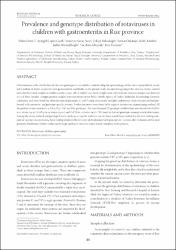| dc.contributor.author | Dereci, Selim | |
| dc.contributor.author | Çiçek, Ayşegül Çopur | |
| dc.contributor.author | Acar, Sümeyra Savaş | |
| dc.contributor.author | Bakkaloğlu, Zekiye | |
| dc.contributor.author | Özkasap, Serdar | |
| dc.contributor.author | Kanber, Kadri | |
| dc.contributor.author | Hacısalihoğlu, Şadan | |
| dc.contributor.author | Albayrak, Yücehan | |
| dc.contributor.author | Durmaz, Rıza | |
| dc.date.accessioned | 2020-12-19T19:58:20Z | |
| dc.date.available | 2020-12-19T19:58:20Z | |
| dc.date.issued | 2015 | |
| dc.identifier.citation | ereci, S., Çopur Çiçek, A., Savaş Acar, S., Bakkaloğlu, Z., Özkasap, S., Kanber, K., Hacisalihoğlu, Şadan, Albayrak, Y., & Durmaz, R. (2015). Prevalence and genotype distribution of rotaviruses in children with gastroenteritis in Rize province. Bosnian Journal of Basic Medical Sciences, 15(3), 35–39. https://doi.org/10.17305/bjbms.2015.469 | en_US |
| dc.identifier.issn | 1512-8601 | |
| dc.identifier.issn | 1840-4812 | |
| dc.identifier.uri | https://doi.org/10.17305/bjbms.2015.469 | |
| dc.identifier.uri | https://hdl.handle.net/11436/2950 | |
| dc.description | Bakkaloglu, Zekiye/0000-0001-9137-016X | en_US |
| dc.description | WOS: 000361745100005 | en_US |
| dc.description | PubMed: 26295292 | en_US |
| dc.description.abstract | Determination of the distribution of rotavirus genotypes is essential for understanding the epidemiology of this virus responsible for nearly half a million of deaths in patients with gastroenteritis worldwide. in the present study, we aimed to genotype the rotavirus strains isolated from diarrheal stool samples in children under 5 years old. A total of 1297 fecal samples were collected, and rotavirus antigen was detected in 73 of these samples. Antigen-positive samples were transferred to the Public Health Agency of Turkey, Molecular Microbiology Research Laboratory, and were tested for determination of genotypes G and P using semi-nested multiplex polymerase chain reaction method performed with consensus- and genotype-specific primers. Twelve specimens were found to be negative for rotavirus in genotyping method. All the positive-strains were in G1-4, G8-9, P(4), P(8), and P(9) genotypes. the most frequent GP genotype combinations were found to be G9P(8) in 21 strains (34.4%), G2P(4) in 14 strains (23.0%), and G1P(8) in 12 strains (19.7%). We found 10 distinct genotypes amongst a total of 61 strains. Among the strains isolated and genotyped in our study, 90.2% (55/61) and 67.2% (41/61) have already been included in the two existing commercial vaccines. in conclusion, these findings implicate the necessity of development of region-specific vaccines after evaluation of the local genotype distribution. Further studies on the large number of rotavirus strains would contribute to this process. | en_US |
| dc.language.iso | eng | en_US |
| dc.publisher | Assoc Basic Medical Sci Federation Bosnia & Herzegovina Sarajevo | en_US |
| dc.rights | info:eu-repo/semantics/openAccess | en_US |
| dc.subject | Rotaviruses | en_US |
| dc.subject | Children | en_US |
| dc.subject | Genotyping | en_US |
| dc.title | Prevalence and genotype distribution of rotaviruses in children with gastroenteritis in Rize province | en_US |
| dc.type | article | en_US |
| dc.contributor.department | RTEÜ, Tıp Fakültesi, Dahili Tıp Bilimleri Bölümü | en_US |
| dc.contributor.institutionauthor | Dereci, Selim | |
| dc.contributor.institutionauthor | Çiçek, Ayşegül Çopur | |
| dc.contributor.institutionauthor | Özkasap, Serdar | |
| dc.contributor.institutionauthor | Hacısalihoğlu, Şadan | |
| dc.contributor.institutionauthor | Albayrak, Yücehan | |
| dc.contributor.institutionauthor | Kanber, Kadri | |
| dc.identifier.doi | 10.17305/bjbms.2015.469 | |
| dc.identifier.volume | 15 | en_US |
| dc.identifier.issue | 3 | en_US |
| dc.identifier.startpage | 35 | en_US |
| dc.identifier.endpage | 39 | en_US |
| dc.ri.edit | oa | en_US |
| dc.relation.journal | Bosnian Journal of Basic Medical Sciences | en_US |
| dc.relation.publicationcategory | Makale - Uluslararası Hakemli Dergi - Kurum Öğretim Elemanı | en_US |


















